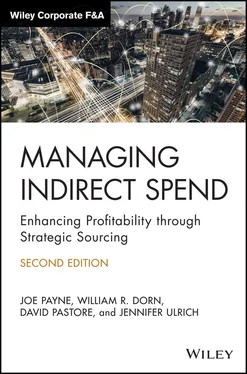1 ...7 8 9 11 12 13 ...20 While you probably will not get the attention of the executive team on a weekly basis, try to establish a monthly meeting to report status and present findings. At the very least, you should be providing a regular, written status update. This way, if you run into a roadblock that requires their attention, they will already be aware of your progress.
End users and other interested parties should be aware of the initiative as well. As we discuss later, end users have a stake in the project. After all, they are dealing with the day‐to‐day realities of working with the supply base. Try to form a cross‐functional team that includes members of several different departments: Finance, Procurement, Operations, and other affected parties. Having a cross‐functional team allows you to get the perspectives of a diverse group within the organization and aids in consensus building as initiatives continue.
Depending on the scope and breadth of the initiative, you will likely assign other resources to help collect data and perform research. These resources could include members of the cross‐functional team, end users, or others within your organization, and they should participate in the kickoff and meet at least biweekly throughout the project. During these meetings, members of the team can report status, troubleshoot issues, and solicit advice on current initiatives.
You have now identified project categories, developed a project road map, identified end users (and other interested parties), and introduced your plans to the executive team. Other than supplier name and spend, you still do not have a clear concept of the specific products purchased, nor do you know the details of that particular supplier relationship. The next step is to add some context to the data you have analyzed. The best way to do this is through end‐user interviews.
End users can take many forms. They could be the people who currently interact with a particular supplier or group of suppliers, or the people who receive or use the product. The end user could even be the person who initially established the relationship with that supplier, even if that person has long since moved into a different position within your organization.
In most cases, a particular initiative would have multiple end users within the organization. These end users include everyone from buyers to Finance to engineers and beyond. Depending on your history with the supplier and the category you're sourcing, one or all of these types of end users could provide important information. It is critical to get feedback from anyone who has a stake with the supply base, directly or indirectly. Otherwise, you may overlook some aspect of servicing, or a unique attribute of the current supplier, that could cause a lot of anguish during an implementation phase if it were absent.
Initial end‐user discussions should seek to accomplish several things. First, they should build buy‐in and sponsorship for your initiative. Second, they should provide you with a detailed understanding of the current relationships with suppliers, including a history of the relationship, the reason that a particular supplier is used, and the quality and service requirements that are required if an alternate is to be considered. Third, you should set ground rules regarding the roles and responsibilities of the end user during the sourcing and negotiations phase. Let's discuss each of these points in detail.
People tend to fear the unknown. Poking your head into an area that someone else manages can make that person feel uncomfortable. An end user who is reluctant to engage has the ability to negatively affect the initiative by providing incomplete information, talking to suppliers without your knowledge, or providing the incumbent supplier with details that should not be disclosed to them. An end user could even tell his or her favorite supplier, “Do not worry about this initiative. We will never change vendors.” Such a response could upset negotiations with the incumbent further down the road.
Most times, a brief introduction to the project and an explanation of what you are trying to accomplish is all the prompting an end user needs to engage with the process. If you sense that end users are still reluctant to participate, however, you can take several steps to ensure they are on board.
First, let them know that they are not being singled out. It is important for them to understand that there is an effort to reduce costs and improve bottom‐line profitability across the organization. Their participation is critical to the process.
Second, let them know that the success or failure of the project is tied directly to their engagement and collaboration. Be direct and make sure they know you recognize that they have the power to upset the applecart, but also that you are not going to allow it.
Third, tie the project to the end user's list of objectives for the year. If there are some end users who do not report to you, work with their direct supervisors to include this project in the next performance review.
Fourth, make sure they understand that a well‐managed, collaborative process will ensure their suppliers have a fair shot at retaining or growing their business with your organization. This translates to a healthier relationship where both sides benefit from the exercise.
If it is not clear that you have end‐user support after initial discussions, it is critical to engage senior level management to enlist the support you need. Otherwise, all the work you do after this step could go to waste.
Understanding the Project Category
Now that you have end users engaged, it is time to mine them for information. It is likely that the end user is working with the incumbent supply base for a given category on a regular basis, fielding offers and sales pitches from alternate vendors. They probably have at least a basic understanding of the marketplace. This base knowledge has advantages and disadvantages. The key advantages are that the end user can give you a detailed picture of how suppliers work with your organization. They can also give you a good historical perspective on supplier relationships.
What end users probably cannot give you (though they may think they can) is an objective perspective of the marketplace as a whole. After years of managing a category the same way, many people stop exploring alternatives and become closely tied with existing processes. Changing suppliers at a substantial cost savings may be possible, but end users could be reluctant because it would mean they would have to work with the supplier a different way. Even if the new process is more efficient or would mean less work for end users, there could be reluctance if they perceive that they would need to change their internal processes.
It is important to note that it's unfair to characterize all end users as subjective thinkers that care only about maintaining the status quo. Many are objective, have done their homework, and have a great understanding of the marketplace and the opportunities available. Others (whether or not they possess detailed information) are not happy with current suppliers and are ready for a change. Regardless, the critical consideration here is that you, as the project lead, remain objective and do not become tied into old ways of thinking about supplier relationships specifically or the marketplace in general.
As we detailed earlier in the chapter, there are several types of end users. Some could be buyers, others could be Finance people, and still others could be engineers or members of your organization's Operations team. Based on the category and the role of the end user, the types of questions you will want to ask can be very diverse. In Part Fourof this book, we detail specific project examples and provide a recommended list of end‐user questions for those examples. In general, there are eight categories you should review with your end users.
Читать дальше












